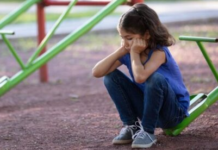Mad in America’s Parent Resources Q&A section is a safe place to ask questions and share concerns about children, families, and alternatives to conventional psychiatric treatments and have them answered on site by one of our subject experts. Please email your questions to [email protected]. Your identity will be kept confidential. Questions may be edited for length and clarity. An archive of past Q & A’s can be found here.
Question:
My child talks about wanting to die. She is only 9 years old. There is so much information out there about what family or friends should say to people who are suicidal, but I’m wondering if there is special advice for supporting a child or young person versus an adult.

Reply from Steve McCrea, MS
I have been honored to have been able to help people who were considering whether or not their lives were worth living, having worked at a suicide hotline for three-and-a-half years and encountered many adults and children who were thinking about suicide as an option to solve their problems. Most of my experience with children who felt suicidal came during my 20 years as an advocate for foster children through the CASA (Court Appointed Special Advocates) program in Portland, Oregon.
I’m not sure there’s a huge difference between the approach one should take with suicidal adults versus kids, except that in kids’ case, they are usually feeling trapped by the action of adults who have power over them. For instance, many of the kids I worked with found school extremely demoralizing, particularly when they were dealing with being bullied. Even worse, in some situations, their “bully” was the teacher, and the child felt trapped because they didn’t believe there was any way to escape. And frequently, the adults in the situation lacked the skills or the motivation to intervene.
Foster children are particularly susceptible to feeling like giving up on life, as they have usually experienced repeated abandonments, failures, or hostility when asking for help from the adults in their lives. Most learned very early that they were on their own, so things that might seem like “normal” problems easily became overwhelming for some of these young people.
A Problem Seeking an Answer
Very young people (and older ones) who are considering suicide almost always see ending their life as a solution to a problem they are experiencing. There is a big temptation to reassure the child that it’s not so bad, or to explain to them why suicide is not the solution. This logical approach generally backfires for two reasons. First, when we offer reassurances, we are invalidating the feelings of someone who genuinely believes there is no easier way out of a situation that feels unbearable. Second, suicidal ideation is rarely the real issue with children; it is a proposed solution to their specific problem, so telling someone not to kill him or herself without coming up with an alternative solution is going to leave that person feeling both misunderstood and just as stuck as ever.
My approach to suicidal fantasies is generally about normalizing these feelings and helping the youth figure out what problem they think would be solved by being gone from the world. For instance, a person who is being bullied at school for being “different” (whether due to sexuality, race, disability, social awkwardness, being “too smart,” or any other presentation that others use as an excuse for teasing) is looking for a way to stop having to deal with these bullies day after day. Almost everyone can empathize with that feeling. The first order of business, then, is to have the child tell you their story, including all the emotions attached to it. Then, let them know that you can see why this situation might cause them to despair, and that killing oneself is a pretty common fantasy when we are feeling hopeless about changing our situation.
This approach requires a lot of listening and patience, courage, and willingness to sit with the discomfort of knowing that a young person is thinking of hurting themselves, including facing up to this person’s feelings of powerlessness, which are often reality based. But this type of witnessing or “holding space” is the key to helping the person to decide to move away from thoughts of ending their life. The child must first understand that they are not alone, that they are understood, and that they are not being judged for thinking the unthinkable. When the other person knows that you’re not going to panic at the word “suicide” but will hang in there and let them feel their feelings, they can begin to explore why they feel this way and start to imagine some other possible actions to take instead.
Assess the Situation
Before you start that brainstorming conversation, though, there are a few things to consider.
Serious Intent
It is important to evaluate how seriously the child is considering suicidal action. In the case of a young person who is sitting with a handful of pills and says they’re about to swallow them, the first step is to make sure that the means of actually going through with the act are addressed so that a discussion can take place. This may be as simple as an agreement that the person will put down the pills long enough for you to have a conversation with them about what’s going on that drove them to this point. There are many different philosophies on how to handle this kind of situation, the most common one being to call the police and have the person held against their will in a medical facility. However, research has found that this approach is likely to further traumatize the person.
Drug Effects
Recently, there has been a movement to label adults or children who talk about suicide as mentally ill, typically as having “major depression,” and the first-line intervention after diagnosis is often “antidepressant” drugs. Unfortunately, long-term research indicates that antidepressants don’t reduce suicide rates in adults, and especially not in children. In fact, most antidepressant medications are required to have a boxed warning that they may increase the likelihood of suicide or suicidal thoughts, especially in youth.
In my earliest clinical experience, which took place in the 1980s and early 1990s, suicidality in children was very, very rare. I am convinced that the widespread, reflexive use of psychiatric drugs—plus the removal of other accommodations such as counseling, support groups, special education interventions, and the like (after all, if it’s a brain problem, then the drugs should handle it, right?) —has led to a loss of adult competence in handling kids’ emotional issues. And the drugs themselves are likely directly responsible for many cases of children feeling/acting suicidal.
I have encountered a few situations in which a child appeared to become suicidal as a reaction to the antidepressant Prozac. In one case, during my advocacy for foster youth, a girl of 10 or so had been prescribed that drug while in a facility for anxiety issues. Within days, she reported feeling suicidal for the first time in her life and told her CASA volunteer that it was weird; she didn’t really understand why she felt that way. The CASA effectively advocated for her to be taken off the drug and the girl’s suicidal feelings vanished.
So, any time a child expresses suicidal feelings, first check for drug effects. Ask when these feelings started, whether they make sense to the person, and if there were any drug changes within a few weeks of the initial change in mood or thinking. If there appears to be a connection, advocate for the drugs to be discontinued for at least several weeks and observe whether or not the suicidal feelings abate.
Abuse
It is also vital to remember that kids’ suicidality can the result of being trapped in an abusive situation, whether it’s at school, at home, in a foster home, or in an institution (like a residential treatment or juvenile justice facility). Kids may be absolutely correct in believing that there really is nothing they can do about their current circumstances. So, in opening this conversation with them, you as a caring adult have to be willing to understand this hard reality, and stand up and fight for their rights and their safety if necessary. “Thinking positive thoughts” doesn’t work very well when you’re worried your dad might kill your mom the next time he gets drunk, your uncle is molesting you, or you and your mom are homeless and living in your car. So be prepared to hear some things you might not want to hear, and to take action yourself if becomes clear that it is necessary for the child’s well-being.
Action Steps
After checking for seriousness of intent, drug effects, and abuse, these are the steps I recommend trying:
-
Validate/normalize
Let the child know that you understand their feelings and are not judging them for having them. You can say: “I am guessing you’re feeling pretty desperate to be considering such a drastic solution. I understand that and have sometimes felt that way myself.” (Or if you can’t honestly say that, go with something like “It’s really common for kids of your age to feel like things are hopeless and that there may not be another way out.”) Continue to validate them and probe what’s behind the suicidal impulse: “Life can be pretty tough sometimes, especially for kids. I’m really interested in finding out what problems you’re dealing with that have led you here.”
It is important to keep normalizing their feelings throughout whatever else comes up in the conversation. Take advantage of any opportunity you find to validate their emotions (not necessarily thoughts or behavior), as this is what helps the person believe that you care and are there to help, not to judge. Remember, though actions can be right or wrong, all feelings— including suicidal ones— are always OK to have and to share with you.
-
Identify the underlying problem(s)
What is the issue the person believes suicide might solve? Have the child tell you what’s going on in their life, using very open-ended questions such as, “What’s going on that’s making your life tough right now?” or “Tell me about what’s happening that makes you feel out of control.” Or “What is the one thing you most wish you could change right now?”
It is very common for a person feeling suicidal to say, “It’s just everything” rather than identifying specific issues. This can make it very hard for a person to dig their way out when things get truly overwhelming. Try to get them to name the specific people, situations, and/or events that are distressing them. It’s much easier to deal with “My teacher, Mrs. Rudski, is really mean to me and I hate having to go to class every day,” than “I hate everything about school, and I’d rather be dead than have to go there again.” Similarly, if the child says, “Mrs. Rudski is a bitch to me all the time!” ask the person to tell you what Mrs. Rudski does that is mean, pinpoint at least one specific incident when Mrs. Rudski was mean, and get the details of what happened. This process tends to do two things: It helps the child focus (it’s less overwhelming to talk about specific incidents, so it’s easier for the child to unburden him/herself to you), and it creates more opportunities to normalize and validate their reactions, creating a stronger bond of trust between you and the suffering child. In fact, there may be only one or two incidents that have led the child to these conclusions, and handling them or just talking about them may in some cases bring tremendous relief.
If the child identifies the incident and is willing to talk about it, it’s OK to ask questions about the event, such as where and when it happened, who else was there, what the teacher actually said, what the student said or did, what they wished they had said but held back, how they felt at the time, etc. You want to find events that the child has been wanting to talk about but hasn’t felt safe to do so. If the child really doesn’t want to talk about a specific event, you may be dealing with a more serious trauma, or perhaps you haven’t gained sufficient trust. If you get resistance, don’t push it—go back to validating and normalizing.
For example, I once had a call from a child we’ll call Al, who was about 13. He was feeling trapped because his parents were emotionally abusive to him, and suicide seemed like the only way out. He’d called CPS over and over to report them, but there was no physical abuse and CPS always said they couldn’t intervene, so he’d given up. Al couldn’t think of anything else to do.
I validated him, telling him, “That sounds like a very difficult situation, and it seems that what you really want is to escape, which is quite rational.” But being 13, Al didn’t have a lot of options. I told him I admired his initiative in calling a crisis line at his age. This is sometimes called “reframing” —finding a way to view the client’s actions in a positive light. Rather than seeing his attempts as ineffective, I encouraged him to see them as reflecting courage, initiative, and creativity. Use anything you can come up with to tell the child you genuinely admire their efforts to deal with the massive issues in front of them!
Then, I had Al give me some examples of what he was up against with his parents and empathized deeply and genuinely that this situation sounded horrible. The idea that he’d have to put up with this for five more years before he was legally able to leave home seemed understandably overwhelming.
-
Review other options
The next step is identifying short-term goals the person feels they can work on that could ease their pain and/or help give them a sense of control over the situation. Try asking the person how long they can foresee not taking their life and talking about what they can do in the interim before they check in with you again. That last one can be very powerful—re-engaging in some kind of productive activity often helps get people un-stuck.
Frequently, the suicidal youth spends a lot of time talking about all the things they have no control over and can’t change, though they wish they could. At this point in the conversation, I try to shift over to what they can control. “You’ve got a lot of things you’re describing that you really can’t control. You can’t force your teacher to be nice, you also can’t just decide not to go to school. But let’s talk about some things you can do.” Some examples might include getting support from parents, a counselor, or a supportive teacher to make a formal complaint; talking to other kids in class to see if they have faced similar mistreatment; asking to be moved to another classroom; looking for a different school to attend; or maybe even consider homeschooling.
When it comes to solutions, sometimes you can (or need to) start a lot smaller, like asking in which situation the teacher is mean to her, and then seeing if the child can simply avoid that situation. For example, if the teacher makes fun of her when she goes up to sharpen her pencil, she could bring extra pencils, buy a mechanical pencil, use a pen instead, or whatever ideas she can generate with you to avoid the conflict situation.
Returning to 13-year-old Al, I asked him what he wished were different. He told me that he just wished he didn’t have to deal with his parents any longer. He was a good student, had lots of friends, was easy to talk to, had a good sense of humor — a very likable, capable person who had the misfortune of having drawn a bad ticket in the parent lottery. So, I started our solutions-generating conversation with the idea that he would be able to get away from them when he turned 18, or maybe sooner, but for now, he had to look to that as a future goal and focus on how to survive.
But getting away from them at least part of the time was actually possible, and I suggested that we look at ways he could do that. It turned out that he was interested in sports and other extracurricular activities, so we talked about signing up for any activity that would keep him away from home as long as possible. We talked about his friends and possible overnight stays, especially on weekends. We talked about ways he could minimize contact with his parents even while he was at the home. We talked about viewing his parents as more like landlords, and home as just a place he had to go to sleep. I suggested that other than that, he didn’t really need to spend a lot of time worrying about how the “landlords” felt about him. By the end of our talk, he was generating his own, additional ideas about what he could do to ease his misery, rather than focusing on his inability to escape his parents in the shorter run.
-
Focus on small wins
Remember, the goal of your intervention is not to stop the child from feeling suicidal. It’s to start them feeling just a little bit more in control of their lives, to have them take any action, however small, with the intent of making things just a little better for themselves. Sometimes the outcome of your discussion is, “I am not feeling I will kill myself tonight. I will read my book and see if I can get some sleep, and then try to sort things out in the morning.” That’s a win! It means that this youth has decided that they are OK to keep working at life for one more day. Look for small wins and, as you continue to provide support, the small wins will start to add up to bigger changes over time.
Kids are generally resilient, much more able to handle and bounce back from difficult situations given the proper support than most adult are. They may need a lot of adult assistance in dealing with some very difficult situations, such as being abused or neglected at home, being unsafe at school, or being isolated and lonely due to being “different” and feeling unaccepted. You will need to provide that support for them. This means you may have to do more than just talk with them — you may need to advocate for some real changes to get them out of an impossible situation. And it may take some time. But it starts with being a safe person to talk to: one who doesn’t disparage, deny, or try to change their feelings, and who helps them find some hope that things might be able to improve, even if it’s just a tiny bit at a time.
-
Find additional supports
Once you find out what’s going on with a suicidal child and what possible solutions might look like, it’s very important to consider what other kinds of longer-term supports are available. For instance, a child who is in a domestic abuse situation might benefit from participating in a group for kids who have also experienced abuse. A teen whose dad is a functional alcoholic might need some reading material (books, articles, internet support sites for those with alcoholic parents) or an Alateen referral. As I mentioned, changes in a child’s school environment can make all the difference if that’s where the problem lies.
You, as a parent or family member of a suicidal child, may be struggling with various issues and in need of some kind of support yourself. I’ve found that often, the best way for an adult to help a troubled child is not to send them to therapy, but to seek their own therapy or a peer support group focused on addressing their own issues. In this way, you can become better able to provide your child the support they need at home.
Be the Hope
Being the support or finding other supportive adults that are safe for the child to talk to and count on is truly the most likely thing to help a child feel more hopeful about his/her future. Science shows this. While brain research has been unable to identify specific problems treatable with drugs or other physical interventions, it has discovered much about “neuroplasticity”— the idea that the brain is very flexible even into adulthood, and that emotional damage in childhood can be repaired. The thing that provides the most healing to young brains, research shows, is not “treatment,” but a positive relationship with one or more healthy adults. As Dr. Bruce D. Perry wrote in The Boy Who Was Raised as a Dog: And Other Stories from a Child Psychiatrist’s Notebook, “The more healthy relationships a child has, the more likely he will be to recover from trauma and thrive. Relationships are the agents of change, and the most powerful therapy is human love.”
***
 Steve McCrea, MS, is a mental health professional, advocate, and author who has worked for over 30 years in social services, including over 10 years as a mental health professional. He retired in 2016 after 20 years as an advocate for foster children and is now RVing full-time with his wife, Ginny, while working part-time as a moderator for Mad in America. He lives in Olympia, WA.
Steve McCrea, MS, is a mental health professional, advocate, and author who has worked for over 30 years in social services, including over 10 years as a mental health professional. He retired in 2016 after 20 years as an advocate for foster children and is now RVing full-time with his wife, Ginny, while working part-time as a moderator for Mad in America. He lives in Olympia, WA.















Children and Criticism : Criticism from parents affects how children brains respond to emotional information and Criticism breaks them and they lose the confidence.
Report comment